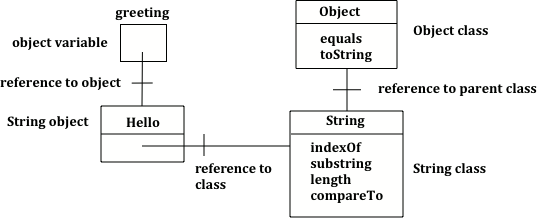This book is now obsolete Please use CSAwesome instead.
4.1. What is a String?¶
Strings in Java are objects of the String class that hold sequences of characters (a, b, c, $, etc). Remember that a class (or classification) in Java defines the data that all objects of the class have (the fields) and the behaviors, the things that objects know how to do (the methods).
4.2. Declaring and Creating Strings¶
You can declare a variable to be of type String.
Note
Class names in Java, like String, begin with a capital letter. All primitive types: int, double, and boolean, begin with a lowercase letter. This is one easy way to tell the difference between primitive types and class types.
Run the following code. What does it print?
The code above declares an object variable named greeting and sets the value of greeting to the Java keyword null to show that it doesn’t refer to any object yet. So System.out.println(greeting); will print null. Object variables refer to objects in memory. A reference is a way to find the actual object, like adding a contact to your phone lets you reach someone without knowing exactly where they are. The value of greeting is null since the string object has not been created yet.

Figure 1: Initial value for an object reference¶
In Java there are two ways to create an object of the String class. You can use the new keyword followed by a space and then the class name and then in parentheses you can include values used to initialize the fields of the object. This is the standard way to create a new object of a class in Java.
greeting = new String("Hello");
In Java you can also use just a string literal, which is a set of characters enclosed in double quotes ("), to create a String object.
greeting = "Hello";
In both cases an object of the String class will be created in memory and the value of the variable greeting will be set to an object reference, a way to find that object. Now that greeting refers to an actual object we can ask the object what class created it. Try the following. What does it print?
The code above will first print class java.lang.String since greeting was created by the String class. The full name for the String class is java.lang.String. The java.lang part is the package name. Every class in the Java language is in a package and the standard classes like String are in the java.lang package. Every object in Java contains a reference to the class that created it. Also, every class contains a reference to its parent class. Yes, a class can have a parent class, just as you have parents. But, in Java a class can only have one parent. A class can inherit object fields and methods from a parent class, just like you might inherit musical ability from a parent. The fourth line will print class java.lang.Object because the parent class (superclass) of the String class is the Object class. All classes in Java inherit from the Object class at some point in their ancestry.

Figure 2: Object variable of type String with a reference to a String object which has a reference to the String class which has a reference to the Object class.¶
